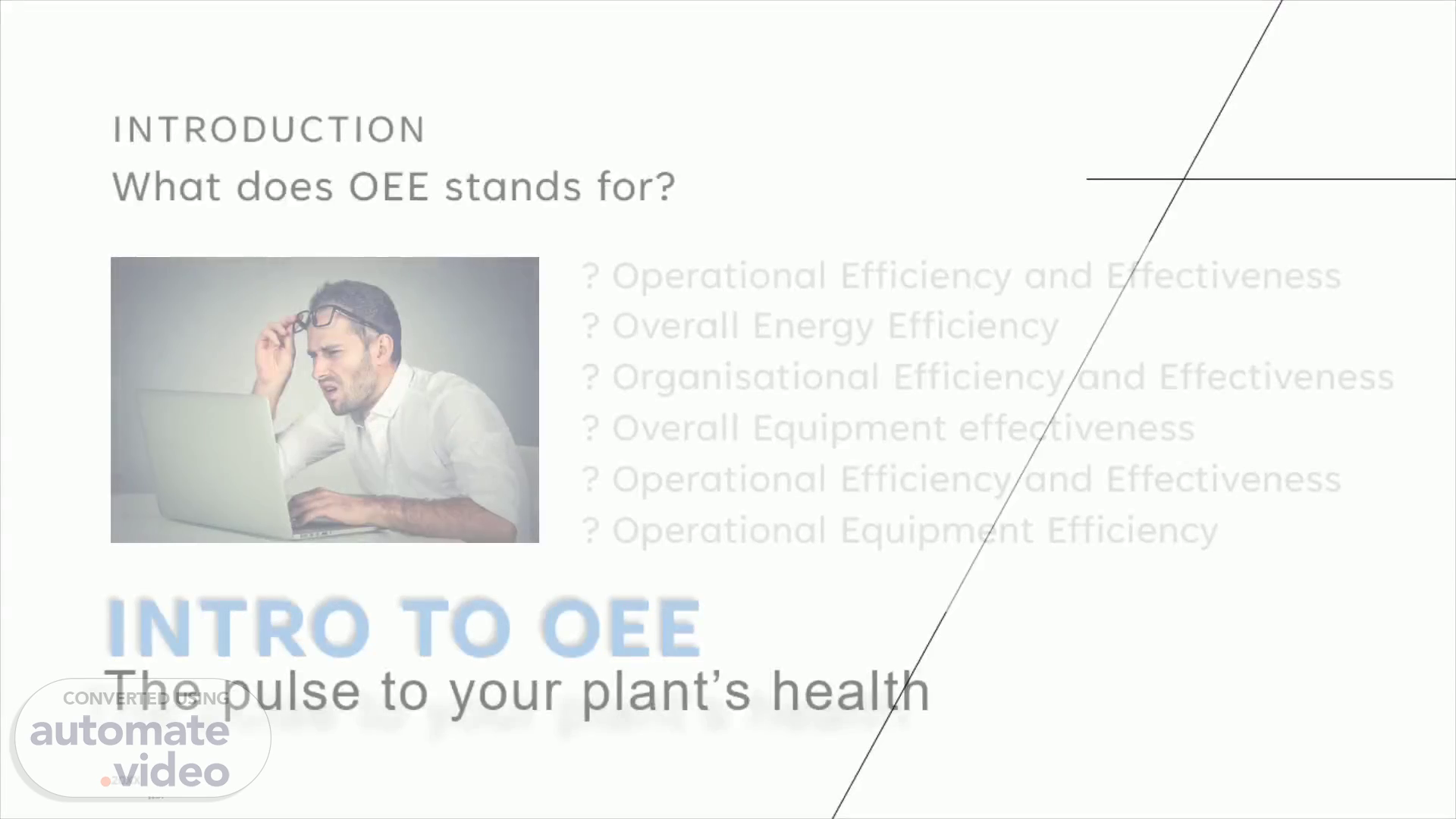Page 1 (0s)
[Audio] Good morning everyone. Today we will be discussing the Overall Equipment Effectiveness metric, and how it can be used to identify inefficiencies and improve operations. We will discuss the benefits of utilizing OEE to maximize production, and ultimately improve the bottom line. Let us begin by discussing what OEE is and what it represents..
Page 2 (24s)
[Audio] OEE is a measure of how well a packing operation is performing when it is running in accordance with its schedule. It takes into account the quality and quantity of output, continuous machine operation, and timely changeovers. At the core of OEE is Efficiency and Effectiveness - Efficiency 'doing the task right', Effectiveness 'doing the right task'. Peter Drucker said it best: 'There is nothing so useless as doing efficiently that which should not be done at all'..
Page 3 (56s)
[Audio] OEE is a measure which provides insight into how well the equipment is running compared to its maximum potential. It is calculated by looking at availability, performance, and quality to determine the frequency of machine downtime, how often it runs slower than usual, and how many defective parts it produces. Tracking OEE regularly can help to pinpoint any problems and prioritize solutions to improve the overall operations..
Page 4 (1m 25s)
[Audio] OEE is calculated by comparing the Actual Output of a production line with its Capable Output. Connecting production data with efficiency indicators enables us to calculate and manage the production performance. OEE is a valuable asset to measure the efficiency of the manufacturing process and maximize its benefit..
Page 5 (1m 46s)
[Audio] OEE is a powerful tool, but can lead to pitfalls if managers are too focused on data accuracy and coding downtime without taking into account how to best leverage the metric. OEE should not be used as an individual performance metric as it is intended to measure different factors. Instead, it should be used for identifying areas of improvement and taking action instead of getting stuck in the data trap. Additionally, it is important to ensure that machine production rates are calculated correctly as they can reflect on the OEE figure..
Page 6 (2m 21s)
[Audio] OEE is an important measure for any plant as it reflects the downtime and units produced in relation to total production time. Our organization has adopted a system wherein the shift operators, GA and production manager all contribute in tracking the OEE score and then report it to higher ups. Additionally, our system also extracts relevant data from timesheets and transfers it to an excel system to make sure all information is accurate and up-to-date..
Page 7 (3m 6s)
[Audio] We understand the significance of measuring our plant's health. To gain deeper insight, Overall Equipment Effectiveness (OEE) is an ideal metric. OEE can help identify potential losses that would otherwise go unrecognized, such as shift changes, material shortages, extended changeovers, non-production overtime hours, and late arrivals of materials. With accurate OEE readings, we can ensure that our operations are operating as effectively and proficiently as possible..
Page 8 (4m 16s)
[Audio] OEE (Overall Equipment Effectiveness) is a metric that assists in determining the value of a plant's output. A high OEE suggests the plant is operating at its best capacity, and the resources used are yielding the best possible rewards. At Aspen, OEE is a major focus as it allows plants to reach their maximum performance capabilities..
Page 9 (4m 47s)
[Audio] We recognize that OEE has a significant influence on our company's competitiveness and profitability. A good OEE score is essential in helping us to boost our sales, income, and recuperation. To make sure that our operations proceed with maximum efficiency and productivity, we constantly monitor our OEE..
Page 10 (6m 10s)
[Audio] At Aspen, we recognize that career growth isn't just a matter of exertion and drive, but of accomplishment. This is why we set challenging yet attainable OEE objectives. Meeting these goals will open up fresh possibilities for employees when it comes to advancement and growth. So join us and be part of the Aspen family, where fresh opportunities await..
Page 11 (6m 51s)
[Audio] Stanley's reactive approach to breakdowns and other plant issues can be a hindrance to achieving a high OEE. Reacting to breakdowns leads to wasted resources and time being dedicated to resolving them. Therefore, it can be beneficial to look into proactive solutions to avoid breakdowns and maximize OEE. To do this, operators should implement preventative maintenance plans to identify potential problems and address them ahead of time. This proactive approach can reduce downtime and the costs associated with resolving breakdowns..
Page 12 (8m 17s)
[Audio] OEE, or Overall Equipment Effectiveness, is a useful tool to evaluate a plant's performance. To make sure the OEE remains intact, it is beneficial to recognize the main aspects which generally lead to a decrease in performance. These can be poor supervision and visibility from managers, as well as spending too much time in office meetings or GEMBA walks. It is essential to properly keep track of and control these activities..
Page 13 (9m 14s)
[Audio] Lack of discipline is another behavior that can cause low OEE. With an operator not addressing breakdowns promptly and using machines for other purposes not related to the process, the productivity and efficiency of the process can suffer. To guarantee a productive and efficient operational environment, having an operator who is adequately trained and accountable is essential..
